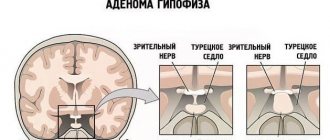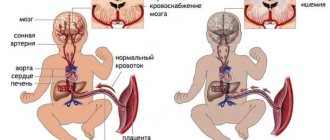How to recognize hepatic encephalopathy and what to do if hepatic coma is suspected? First aid to the patient in this case should be provided by qualified medical personnel as a matter of urgency. It is important for others to recognize the symptoms of this condition in time.
Hepatic coma is the last stage of liver failure, resulting from the effects of endogenous and exogenous toxins on the human brain. The condition preceding this critical condition is called hepatic encephalopathy, which manifests itself as a systemic impairment of cognitive functions, up to irreversible brain damage.
Why does the disease develop?
Hepatic encephalopathy belongs to a group of inflammatory diseases that occur against the background of a weakening of the filtration functions of the liver. The causes and mechanism of development of this pathology are not fully understood, which explains the high mortality rate among patients. Taking into account etiological factors, several of its forms are classified:
- Type A: develops against the background of acute liver failure.
- Type B: occurs with cirrhosis.
- Type C: caused by intestinal neurotoxins entering the bloodstream.
The causes of liver failure, which causes type A encephalopathy, include the consequences of past hepatitis, long-term alcohol dependence and oncological lesions of the liver. The disease can also occur due to poisoning with drugs, narcotic and chemical substances. More rare factors that can provoke type A pathology are:
- Budd-Chiari syndrome;
- consequences of surgical intervention;
- fatty degeneration in pregnant women;
- Westphal-Wilson-Konovalov syndrome.
The second type of hepatic encephalopathy is cirrhosis of the organ, which is characterized by the death of hepatocytes followed by replacement with fibrous tissue. The consequence of such changes is organ dysfunction. The pathological process can develop against the background of:
- frequent bleeding within the gastrointestinal tract;
- chronic constipation;
- long-term use of medications;
- contracting an infection;
- presence of parasites in the body;
- renal failure;
- burns, injuries.
The triggers for the occurrence of type C hepatic encephalopathy are not background liver pathologies, but intestinal pathogens and neurotoxins. With this form of the disease, severe neurological symptoms are observed. The main cause of this type of hepatic encephalopathy is the rapid growth and division of the intestinal microbiota, which is explained by:
- excessive consumption of protein foods of animal origin;
- consequences of portosystemic shunting;
- active course of chronic duodenitis, colitis, gastroduodenitis.
Reasons for the development of encephalopathy
- alcoholic, viral, toxic hepatitis;
- alcohol poisoning;
- industrial poisoning;
- poisoning with mushrooms or medications.
It can also occur as a result of liver ischemia, Westphalia-Wilson-Konovalov disease, acute fatty degeneration in women during pregnancy, as well as severe bacterial infections.
Approximately 15% of cases of the disease occur for unexplained reasons. Acute encephalopathy can develop as a consequence of necrosis of liver cells, in which parenchymal failure factors dominate. Most often, the outcome of acute encephalopathy is the patient's immersion in a coma.
When a patient has chronic liver problems, encephalopathy may occur as a result of:
- forced diuresis;
- gastrointestinal bleeding;
- paracentesis;
- surgical operation;
- infectious disease.
Development is also possible due to:
- increasing protein intake;
- inflammatory processes in the intestines;
- portosystemic shunting.
We have found that in most cases, hepatic encephalopathy is the result of liver problems.
But, besides this, there are other factors that provoke the development of the disease:
- Bad habits, excessive smoking and addiction to alcohol;
- Reaction to anesthesia used for surgery;
- The presence of chronic diseases and their exacerbation;
- Internal bleeding.
The pathogenesis of PE is based on damage to the brain by toxins coming from the intestines.
Normally, the liver acts as a natural filter. Without this organ, which occupies a special place in the functioning of the entire body, a person would be poisoned by ordinary drinking water.
The task of the gland is active cleansing, elimination of toxic substances and dangerous compounds. Such a biochemical “factory” works constantly.
Due to the high load, the liver has an amazing ability to regenerate and recover without outside help. But this trait does not always help.
With many diseases, correction and self-regulation become impossible. In total, three general mechanisms for the formation of encephalopathy in liver disorders can be distinguished:
- Chronic disorders. Diagnoses such as chronic alcoholic, viral hepatitis and others. All such disorders are accompanied by severe changes in the functioning of the organ.
At a certain point, it loses a large share of its own capabilities and is no longer able to adequately perform filtering. Then the decompensation of the pathology begins, the development of symptoms. Without help, death is a matter of time.
- Cirrhosis. Acute hepatonecrosis or death of liver cells as a result of certain factors. Usually it has a rapid development, course, complete destruction and death of the patient occurs in a matter of months. But options are possible.
In any case, the affected liver is no longer able to function as before. Constant support with medications or an organ transplant is needed, which can save the patient in the first stages, before bleeding begins.
- Impaired filtration and purification due to increased formation of intestinal toxins. Absorption of hazardous substances that are naturally formed as a result of the breakdown of protein in food. Normally, a person does not notice his own biochemical processes. But this is not the situation.
Next, PE proceeds according to a previously known scenario. Toxic components poison the blood and enter the brain, causing depression of higher nervous activity, and then the gradual death of cells.
Recovery in later stages is impossible. A neurological deficit is brewing such as behavioral disorders, extrapyramidal symptoms, personality changes, decline in intelligence and the development of dementia.
Further, consciousness is depressed. First there is stupor, then coma. Death occurs in 9 out of 10 patients, the prognosis is extremely serious.
Pathogenesis of the disease
To understand what hepatic encephalopathy is in humans, one should turn to the physiological characteristics of the human body. As you know, ammonia is produced in our muscles, kidneys, liver and large intestine. In a healthy person, this substance is transported along with the bloodstream to the liver, where it is converted into urea. This metabolic process prevents the absorption of toxic elements into the bloodstream. With hepatic encephalopathy, metabolism is disrupted and ammonia, entering the blood, affects the central nervous system.
Intoxication occurs due to the destruction of the blood-brain barrier. Toxic substances stimulate the production of glutamine and slow down the rate of sugar oxidation. As a result, edema forms and energy starvation of brain cells occurs. In addition, in addition to ammonia, amino acids enter the brain tissue, which are concentrated in its structures, causing inhibition of the enzyme system and inhibition of central nervous system functions. As the disease progresses, the ratio of amino acids in the blood and cerebrospinal fluid decreases significantly. Normally, this indicator is within 3.5 units, and with hepatic encephalopathy it barely reaches 1.5.
During a toxic attack, the concentration of chlorine also increases and the conduction of nerve impulses slows down. All this leads to acute liver failure and changes in the acid-base composition of the blood (increased amounts of ammonia, fatty acids, carbohydrates, cholesterol), and electrolyte imbalance. These disorders have a catastrophic effect on the state of astrocyte cells, which are the main protective barrier between the brain and the bloodstream that neutralizes toxins. As a result, there is a significant increase in the volume of cerebrospinal fluid, which leads to increased intracranial pressure and swelling of brain tissue.
It is noteworthy that a disease such as hepatic encephalopathy can be chronic or occur episodically, leading to a spontaneous outcome. Often the chronic form of the pathology lasts several years in patients with cirrhosis.
Symptoms
The term “encephalopathy” in medicine means a disorder of the brain (“encephalon” - brain, “pathia” - disease). It can occur as a result of various non-inflammatory reasons: disturbances in the blood supply to the brain (for example, due to damage to the vessels that feed it, atherosclerotic or diabetic processes), changes in metabolic processes in it, damage to it due to injury.
The symptoms of encephalopathy in all these cases will be very similar. Therefore, with a gradual deterioration in brain function, no doctor can say without an examination why a person suddenly began to talk, forget words and events, or lose orientation.
Another thing is acute hepatic encephalopathy. It develops according to special rules, so it has its own characteristics.
Acute hepatic encephalopathy
Stages of hepatic encephalopathy
Its symptoms appear in a strictly defined order, which allows us to distinguish 4 stages of hepatic encephalopathy:
Stage 1 is called precoma I
This is a condition that should force the patient’s relatives to urgently call an ambulance. Its development may be indicated by hiccups that appear with jaundice, vomiting or bleeding gums.
Precoma I is manifested by a change in mood: the appearance of uncharacteristic depression, anxiety or, conversely, a very good mood. A person can look for non-existent things, express crazy ideas, but answers questions almost adequately and recognizes those around him.
A person becomes drowsy during the day and suffers from insomnia at night. He misses a little when performing the finger-nose test; my hands tremble a little when doing this. If you perform an EEG (electroencephalogram) at this stage, you can see disturbances in the alpha rhythm: its irregularity, an increase in the amplitude of the waves.
Initial stages and their symptoms
At the beginning of the disease, no obvious symptoms are observed. The first degree of subcompensation may be accompanied by periodic psycho-emotional disorders, mild tremors of the limbs, sleep disturbances, and barely noticeable jaundice of the skin and mucous membranes. Patients often notice that they become distracted, inattentive, and lose the ability to concentrate on anything, but do not attach much importance to these symptoms. Many people are not even aware of hepatic encephalopathy of the first degree, believing that the cause of intellectual impairment is fatigue, illnesses suffered in the recent past, vitamin deficiencies and other factors.
The next stage of encephalopathy has greater clinical severity. Hepatic decompensation of the second degree is manifested by asterixis (inability to maintain a certain posture, tremors of the limbs) and symptoms such as:
- violations of the daily routine, characterized by stable drowsiness during the day and insomnia at night;
- prolonged fixation of gaze on one point;
- monotonous, slurred speech;
- visual hallucinations;
- forgetfulness;
- gradual loss of writing skills;
- pain in the right hypochondrium;
- increased irritability;
- sudden mood swings: a state of euphoria can suddenly give way to apathy.
At the second stage of hepatic encephalopathy, the patient becomes lethargic, withdrawn, speaks slurred and gives laconic answers to any questions, close to “yes”, “no”. As a result of the disease, motor coordination suffers and spatial disorientation develops.
Another specific manifestation of this disease is widespread, uncontrollable twitching and muscle tics. Unconscious motor activity occurs with strong tension in the muscles of the body and limbs. To check whether the patient has such a symptom, he is asked to stretch his arms in front of him: the test is considered positive if flexion-extension reflex movements occur in the joints of the fingers and hands. As the pathology progresses, the patient ceases to recognize the shape of objects, and he develops urinary and fecal incontinence.
Stages of PE
Although many equate the concepts of hepatic encephalopathy and coma, the latter is, in fact, an extreme stage of progressive pathology. The encephalopathic condition is reversible, and therefore, diagnosed in the early stages, it is characterized by a favorable prognosis. Coma leads to death in 80% of cases.
| Stage | Symptoms | ||
| Prodromal, mild (100%) |
| ||
| Moderate (60–75%) |
| ||
| Heavy (30%) | cerebral: | pyramidal: | extrapyramidal: |
| these are pathological unnatural reflexes that characterize reactionary movements in the kneecap (clonus) and big toe (Babinski syndrome); |
| |
The percentage of patient survival when diagnosed at a specific stage of PE is indicated in parentheses.
Pyramidal symptoms are classic signs of hepatocerebral degeneration (Wilson-Konovalov disease) and spastic paraparesis. This complication of hepatic encephalopathy begins with a violation of the reflex sensitivity of the lower extremities. This is followed by swelling and muscle weakness, followed by difficulty bending the knee, hip and ankle. As a result, a person develops an unsteady gait.
In people with joint diseases, the manifestations of arthrosis, arthritis and gout increase. Many patients, as PE progresses, are unable to step on their heel.
Irreversible changes in the final stages
Hepatic encephalopathy grade 3 is considered incurable. There is practically no chance of a successful outcome for such patients. This stage of pathology development is characterized by stupor - this condition is characterized by deep depression of consciousness with loss of voluntary activity, but the presence of conditioned and some acquired reflexes.
In the third degree of hepatic encephalopathy, the following clinical manifestations are observed:
- hyperventilation (the patient is breathing heavily);
- lethargy, numbness;
- a sweetish odor emanates from the oral cavity;
- against the background of increased muscle tone, convulsive and epileptic seizures often occur.
A patient suffering from this pathology often freezes in one position and falls into a stupor. A person can be brought out of a stupor only by physical force, after which weak facial contractions appear in response to pain. In the future, stupor can lead to coma.
The last stage of progressive hepatic encephalopathy is the patient’s comatose state. A person loses consciousness and reflexes, not reacting to stimuli. In isolated cases, muscle clonus is possible, which is characterized by the unconscious manifestation of primitive reflexes (sucking, grasping). The patient's pupils do not respond to light, the sphincters are paralyzed, convulsions and respiratory arrest occur. The immediate cause of death in hepatic encephalopathy is cerebral hydrocephalus, pulmonary edema, and toxic shock.
Classification of the disease
Depending on the severity of the symptoms of hepatic encephalopathy, the disease can be open or latent. The hidden nature of the pathology is most dangerous for the patient. By the way, according to statistics, asymptomatic liver encephalopathy is diagnosed in 60% of cases of cirrhosis.
There are also acute and chronic hepatic encephalopathy. The first progresses rapidly and can develop a couple of days before the comatose stage. Signs of chronic hepatic encephalopathy are less pronounced, and the course of the disease can last for many years.
Coma due to encephalopathy can be true (endogenous) or false. In the first case, we are talking about fulminant damage to the central nervous system in persons suffering from liver failure or cirrhosis. With chronic hepatic encephalopathy, false (exogenous) coma often occurs. This condition is less dangerous for the patient, and with timely intensive therapy, doctors are able to bring the patient to consciousness. But despite this, the prognosis does not leave hope: in 90% of cases, patients die within the first month.
Reasons for the development of encephalopathy
The clinical picture depends on the type of pathological process and its aggressiveness.
The complex of manifestations is severe, patients can die in a matter of hours.
Possible signs include:
- Confusion. The sufferer becomes apathetic and has trouble thinking. Responds sluggishly or not at all to surrounding stimuli. Stupor develops within a few hours. Reflexes are still preserved. Therefore, theoretically, the patient can still be brought out of this emergency state. Then coma sets in. The situation is critical, recovery becomes unrealistic. Another name for this complex of phenomena is hepatargy.
- Tachycardia. Increased heart rate. Up to 120-180 per minute without an increase in pumping function and myocardial contractility. This is what is called “idle” work, because there is no effective nutrition of the brain. A change in heart rate is dangerous due to rapid cardiac arrest. Therefore, the symptom itself is threatening.
- Tremor of the asterixis type. Asymmetrical trembling of the hands, torso, and neck with sudden significant tension in the skeletal muscles. Essentially, this is the result of a transient cyclical disorder of muscle tone. The clinical sign is considered typical for hepatic encephalopathy.
- Dizziness. Problems with orientation in space. The person cannot understand his position and takes a forced lying position. Because any movement provokes severe discomfort. The manifestation is the result of damage to the extrapyramidal system. In particular, the cerebellum and the occipital lobe of the brain are affected.
- Nausea, vomiting. Transient. Regardless of food. An irresistible urge to empty the digestive tract is possible, including with a complete lack of food in the previous few hours.
- A sharp decrease in reaction speed. Unable to respond to rapid stimuli. Like calling out, physical pressure. General inhibition is typical for brain lesions of varying severity.
- Dyspnea. A disorder of the natural process is the result of the body’s attempts to compensate for the insufficient supply of blood and nutrients with oxygen to the cerebral structures. This is a typical manifestation of hepatic encephalopathy.
Recovery requires the introduction of a gas mixture; artificial ventilation is possible in case of critical health, coma or stupor.
- Falling blood pressure levels. The change in blood pressure indicators is rapid. Asymmetrical. Either a decrease or a sharp increase.
Such signs are very dangerous, since critical changes can provoke a stroke. With a further decrease in blood pressure, cardiogenic shock and coma occur.
Signs of hepatic encephalopathy in the acute phase can develop after a protracted, sluggish course of the disease, because at a certain point decompensation occurs with the formation of a full-fledged disorder of brain function.
There can be many options. To avoid critical complications, you need to undergo timely treatment.
In the case of a sluggish course of the pathological process, it is necessary to consider the clinic from the perspective of the stage of change. Classification involves four stages.
First stage
He's prodromal. This is the starting point. There are no violations as such yet. But there is one or another liver disease. From hepatitis to others that indirectly affect the organ. In this case, there are no typical manifestations of encephalopathy yet.
Second stage
The clinic is already present. These are mostly minor behavioral disorders. The person becomes aggressive and more irritable than usual. Some stereotypical reactions to external stimuli arise.
There may be a flattening of affect, emotional dullness, but still to a small extent. Because disruption of brain function is not critical. The level of intelligence drops somewhat. The person copes with tasks worse than before.
Objective changes in well-being: headaches, loss of coordination, spatial orientation, nausea, fear of bright light and sound (attacks), decreased reaction speed. Possible vomiting.
Third stage
Subcompensation. The organ can no longer cope with its own tasks, so neurological symptoms appear in all their glory. In addition to these manifestations, there are signs typical of acute hepatic encephalopathy.
The clinical picture is severe. From this moment on, treatment is possible strictly in a hospital setting, often even in intensive care. Intensive therapy is required.
Fourth stage
Decompensation. Total disorder. The person falls into a state of stupor. It is typical for him to maintain pain reactions during a series of special tests.
It is still possible, although not easy, to remove a person of their position. Then comes hepatic coma. A deep disturbance of consciousness, from which in this case it is extremely difficult or impossible to get out.
Almost 90% of patients die at this stage. Situations of recovery, and especially cure, should be considered a miracle and great luck. But such favorable scenarios in medical practice are casuistry.
Symptoms of hepatic encephalopathy are a complex of neurological, mental, endocrine and some somatic and autonomic disorders. They are not specific enough, but with proper diagnosis, detecting the problem is not difficult.
There are many development factors that can be named. Among the most common:
- Cirrhosis. Acute neurosis of organ cells, which was mentioned earlier. It occurs mainly in patients with alcohol problems. According to statistical data, this is the main reason for the development of the pathological process, but not the only one. In addition, they talk about the use of certain medications and poor diet. Recovery in this case is effective only in the early stages, when there is still an opportunity to help the patient. Elimination of the etiological factor is an important point in treatment.
- Chronic hepatitis. Accompanied by constant or periodic regular inflammation of the liver. In this mode, the organ can work for years, but the negative effect will not be long in coming. It is necessary to treat hepatitis in a timely manner so as not to face a critical problem.
- Uncontrolled use of a number of drugs. Particularly dangerous are non-steroidal anti-inflammatory drugs, antibiotics, some glucocorticoids, other medications, and oral contraceptives. The intake of all possible medications must be coordinated with doctors. In this case, it is strictly forbidden to change the dosage, exceed it, or violate the dosage regimen.
- Excessive consumption of alcoholic beverages. Alcohol addicts suffer from liver pathologies more often than others. Starting from the second stage, when binge drinking occurs, a person does not control himself, therefore the risks of dangerous deviations grow rapidly. Quitting ethanol, detoxification, and coding will be ideal prevention. If there are no violations yet, this is a great success.
- Liver cancer. It is relatively rare. It has nothing to do with cirrhosis. Pathological processes cannot be confused.
- Infections of other parts of the digestive tract. They are found relatively rarely as a cause. These are usually serious chronic or acute diseases that put the liver under excessive stress. She fails to cope with the assigned task.
- Unhealthy diet high in protein compounds. Always causes disturbances in the functioning of the organ.
The causes of hepatic encephalopathy are numerous, but quite monotonous. Although it is premature to say that doctors have thoroughly studied the disease. The pathological process is not fully understood by specialists. Research in this direction is still underway.
The main reasons for the development of this pathological process include the following:
- viral hepatitis;
- alcoholic hepatitis;
- liver cancer and other ailments developing in this organ, which can lead to the development of insufficient liver function;
- poisoning with medications, toxic substances - diuretics, narcotic drugs, sedatives:
- active process of bacterial growth in the intestines;
- eating protein foods in large quantities;
- gastrointestinal bleeding;
- prolonged constipation;
- a large amount of protein in food;
- infections;
- frequent consumption of alcoholic beverages;
- surgical interventions.
Hepatic encephalopathy can occur in acute, subacute and chronic forms.
Acute
For this type of disease, the development of poor liver function occurs suddenly and lasts from two hours to several days. Acute hepatic encephalopathy is accompanied by a very severe course. Against the background of such an illness, hepatic coma quickly develops. The presence of acute viral, drug-induced and toxic hepatitis are the main reasons for the formation of an acute form of hepatic encephalopathy.
Subacute
This disease is characterized by the slow development of hepatic coma. Estimated time is a week or more. The disease of the subacute type is characterized by a relapsing course, therefore, before the symptoms of the exacerbation phase occur, the condition of the patients is satisfactory.
Chronic
Chronic liver failure develops against the background of liver cirrhosis, accompanied by portal hypertension. In this condition, the patient may experience the following symptoms:
- frequent mood changes;
- absent-mindedness;
- decrease in intellectual activity;
- muscle stiffness;
- parkinsonian tremor.
There are several forms of disease progression, depending on the processes occurring in the body:
- Spicy. Characterized by rapid progression and course. Can lead to coma within a few hours after the onset of complications.
- Subacute. As a rule, it proceeds much more slowly. The development of the disease takes no more than ten days and is accompanied by relapses of complications.
- Chronic. Symptoms of the disease increase slowly and this process can take from several months to several years. The problem most often develops as a complication of liver cirrhosis and portal hypertension.
According to the degree of severity and intensity, latent, symptomatic, and recurrent forms are also distinguished.
- Diagnosis of hepatic encephalopathy
- Causes and forms of hepatic encephalopathy
- Treatment and possible prognosis
Survey
To establish a diagnosis, a neurologist must examine the patient, check his reflexes, conduct a survey, listen to complaints, and evaluate the adequacy of responses and behavior. Often, patients go to see a doctor with their relatives, who could complement the description of the course of the disease, help the doctor compile an anamnesis about previous diseases, the patient’s addictions to bad habits, taking medications, heredity, etc.
Laboratory and instrumental diagnosis of hepatic encephalopathy is a complex of complex research procedures:
- Biochemical blood test for liver tests. The study allows you to assess the degree of aminotransferase activity, determine the level of gamma-aminobutyric acid, bilirubin, and ammonia. With encephalopathy in the blood there is a decrease in hemoglobin, albumin, prothrombin, and cholinesterase.
- CSF analysis. An increased presence of protein is found in the cerebrospinal fluid.
- Ultrasound of the liver, gall bladder and abdominal organs. The study is carried out to find out the causes of liver failure. If the screening turns out to be uninformative, a liver puncture is performed.
- Electroencephalogram of the brain. The procedure will allow you to get a real idea of the functionality of the central nervous system.
- MRI, CT. These research methods provide a detailed answer about the location of the affected areas, intracranial pressure, and the severity of the patient.
In addition to the basic diagnosis, in case of hepatic encephalopathy it is important to conduct a differential study to exclude stroke, aneurysm rupture, meningitis, and alcohol withdrawal.
Diagnostics
It is possible to draw conclusions about the presence of hepatic encephalopathy in a patient only if there is a history of liver failure and after test results indicating it. Similar nervous symptoms can be caused by other diseases. Neurology is a complex branch of medicine that inevitably leaves room for error.
Hepatic encephalopathy is diagnosed based on the presence of symptoms of a disorder of nervous activity, results of blood tests, urine, stool, ultrasound (CT or MRI) and a history or diagnosis of chronic liver failure of any origin (viral, toxic, parasitic, cancer, etc. ) or if there is a possibility of a large dose of toxic substances entering the body.
In the last stage, encephalopathy turns into coma. Interestingly, the result of acute and fulminant (fulminant) failure is endogenous, or true coma, with complete shutdown of the liver due to the destruction of hepatocytes (cellular symptom). Hepatic coma of an exogenous nature, which is characterized by death of the liver as a result of lack of blood supply due to compression of blood vessels, manifests itself in the final stage of chronic failure. Mixed coma combines the characteristic features of endogenous and exogenous.
Treatment of acute hepatic encephalopathy
You need to start fighting the disease as early as possible. Treatment of the disease consists of three main stages:
- search and elimination of the factor that provokes liver failure;
- decreased levels of ammonia, chlorine and other toxic substances in the blood;
- stabilization of the ratio of brain neurotransmitters.
In acute hepatic encephalopathy syndrome, therapy begins with the use of diuretics. To relieve swelling of the body and internal organs, the brain, Furosemide and Lasix are administered parenterally.
If the patient's mental disorders are too severe, sedatives are prescribed. Tinctures of valerian and motherwort may not give the expected effect; stronger drugs (Haloperidol, Eteperazine, Invega, Rispolept) are recommended as an alternative.
If the cause of liver failure is a bacterial infection, antibiotics are prescribed to relieve inflammation. For the treatment of encephalopathy, broad-spectrum antibacterial agents are usually prescribed, which are active in the lumen of the large intestine against various microorganisms:
- "Neomycin."
- Vancomycin.
- "Metronidazole".
- "Rifaximin".
In parallel with antibiotics, detoxification solutions are administered intravenously. As soon as the condition has stabilized, they are replaced with nutrient solutions of glucose, sodium bicarbonate, and potassium in order to replenish the deficiency of important microelements in the body.
For hepatic encephalopathy type C, high cleansing enemas with lactulose are used. To cleanse the intestines, which reduces the formation of ammonia and prevents its absorption, the patient is prescribed drugs from the group of disaccharides (Duphalac, Normaze, Goodlak, Lizolak). Together with feces, the toxic microelement quickly leaves the body.
To prevent cerebral edema in the early stages of the disease, hormonal systemic drugs “Dexamethasone” and “Prednisolone” are used. If the general condition worsens, the patient is hospitalized in the intensive care unit.
In case of hepatic encephalopathy against the background of acute liver failure, the patient is urgently referred for liver transplantation. An organ transplant will increase the chances of survival (statistics indicate that 70% of operated people have overcome the five-year threshold). However, due to the high risk of complications and death, early consultation at a specialized medical center is required to select donors and examine the recipient.
Forms of PE
The table above presents the stages of hepatic encephalopathy, describing the progression of damage to the brain and central nervous system. The rate of deterioration of the patient's condition depends on the form of the diagnosed pathological condition and associated trigger factors.
| Form | Subform | Characteristic |
| Acute | – |
|
| Subacute |
| |
| Chronic | continuously flowing |
|
| recurrent |
|
In the acute phase of PE, the patient is agitated and hallucinates, but in the subacute phase, on the contrary, he is apathetic and weakly reacts to external stimuli. The first signs of a person having chronic PE are changes in character: apathy, laziness, lack of interest in the feelings of other people, or vice versa, irritability and nervousness. Here, a person’s temperament plays an important role: a melancholic person will hide alone, a choleric person will begin to blame others for all his problems, and a sanguine person and a phlegmatic person will most likely show indifference to the world around him.
Frequent professional errors (the nurse began to miss an injection into a vein, or the driver began to violate traffic rules too often) may indicate chronic PE.
In addition, doctors use several more forms that describe the characteristics of hepatic encephalopathy in liver cirrhosis, toxic hepatitis and other congenital and acquired diseases of the hepatobiliary system:
- episodic - implies incoming neuro-psychological disorders that can occur when a person’s general condition deteriorates: with weakened immunity, with diseases of the upper respiratory tract, with alcohol intoxication, etc.;
- fulminant (fulminant) - usually develops in acute liver failure caused by toxin poisoning, and is characterized by a rapid increase in the clinical picture;
- spontaneous - manifests itself in the same way as fulminant HE, but it is understood that liver dysfunction occurred without the participation of a hepatotoxic factor;
- persistent - this form is indicated in the patient’s diagnosis when, as a result of acute hepatic encephalopathy, a protracted clinical picture develops that limits daily activity;
- minimal (subclinical) - characteristic symptoms of PE do not appear, however, with the help of instrumental diagnostics, doctors can determine ongoing neurological disorders; This form of PE will still, after some time, turn into episodic and then fulminant.
When examining a large number of patients with liver cirrhosis, it turned out that at least a third of them had subclinical PE.
Diet and diet
In case of acute liver encephalopathy, fasting is recommended for 1-2 days, after which the patient is prescribed a low-protein diet. In case of hepatic encephalopathy, the consumption of plant and animal proteins is limited to 0.5 g per 1 kilogram of body weight per day. In addition to protein products, the consumption of table salt is not allowed. To stabilize the patient's condition, Omega-3 fatty acid complexes are prescribed. With positive dynamics, the daily amount of protein is gradually increased. The volume is increased every five days by 5-10 g, but the patient is allowed to eat no more than 50 g of lean dietary meat (rabbit, chicken, turkey).
It is worth noting that fasting in the first days of acute encephalopathy is not a prerequisite. If the patient’s condition and test results are within acceptable values, it is enough to simply exclude protein foods from the diet, giving preference to low-fat homemade food - soups, cereals, salads, and baked goods. In this case, it is worth paying attention to foods and drinks whose consumption is unacceptable in acute and chronic forms of the disease:
- apples, grapes, cabbage and other vegetables that cause fermentation in the intestines;
- dairy products;
- whole milk;
- alcohol;
- sweet carbonated drinks;
- coffee;
- strong tea.
Hepatic encephalopathy in liver cirrhosis is accompanied by destructive changes in the organ. With successful treatment of the disease, despite the ability of the liver parenchyma to quickly recover, one should constantly adhere to a diet to avoid relapse, since liver cells react acutely to exposure to harmful substances.
Chronic liver encephalopathy, therapy
In the chronic course of the disease, the principles of symptomatic therapy are adhered to. If the disease worsens, it is immediately necessary to adjust the diet and switch to a low-protein diet.
Just as with the acute form of hepatic encephalopathy, treatment involves removing toxic elements from the body. Most often, a two-stage bowel cleansing is required with the help of medications that reduce the concentration of ammonia in the blood. To provide the patient with energy, a glucose solution is administered intravenously. In combination with the use of drugs, hepatic encephalopathy is treated with plasmapheresis procedures.
What are the chances that patients are predicted
The success of treatment depends largely on the severity of the patient's condition. For example, coma almost inevitably leads to the death of the patient. The prognosis worsens with high levels of total protein, albumin, as well as the development of ascites and jaundice.
Among patients with liver encephalopathy in the last stages, less than 25% survive, with the disease at an early stage - more than 60%. The chances of recovery increase after transplantation. But if the patient has irreversible brain damage, he will not be able to return to a normal, full life.
The effectiveness of therapy for this disease is determined by several factors, including the cause of the disease and the age of the patient. For children under 10 years of age and patients over 40, the prognosis is the least optimistic.
Surgical treatment of PE
Sometimes destructive changes in the liver are such that surgical intervention is necessary. This is a portacaval shunt, which partially restores the pressure in the portal vein and maintains blood circulation through the liver. However, such treatment cannot be called complete, since after the operation a constant diet and medication are required to help cleanse the blood.
Other types of surgery, in particular anastomoses, are also only a temporary measure. In case of complete dysfunction of the digestive gland, the only hope may be a transplant of a donor organ or at least part of the liver from a blood relative. However, even with a timely search for an organ, it is necessary to collect a considerable sum of money. And the survival rate of patients with donor organs is far from ideal due to the high risk of transplant rejection by the immune system. Therefore, for most patients, surgical treatment of PE remains unavailable.












